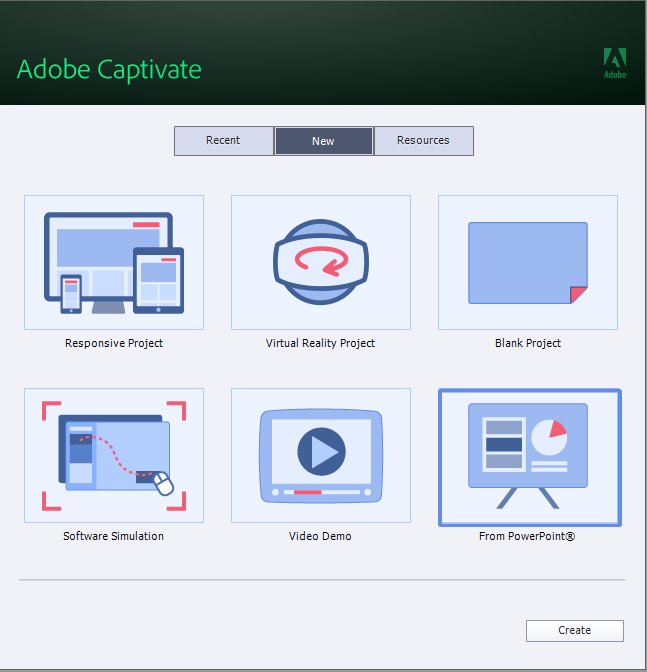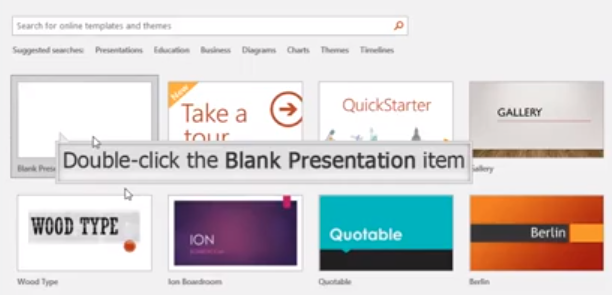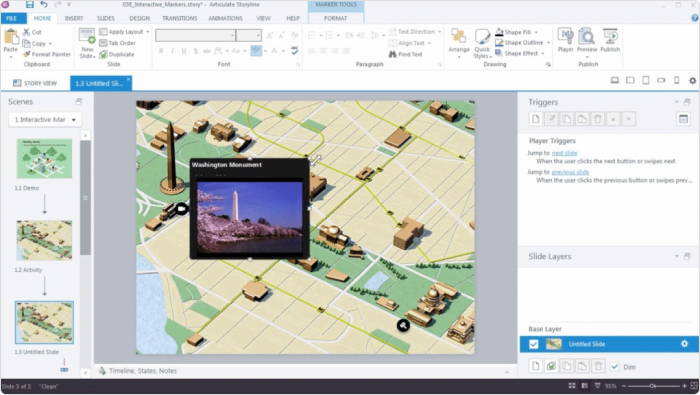Picking a software simulation tool for training your employees is an important decision. Here we help you scrutinize and pick the best one among three top 2025 learning software tools that suits your business needs.
Introduction
All software simulation tools are not created equal. Substantive research should go into this process. And we have done just that for you. This post will show you how to assess a software simulation tool, followed by a detailed analysis of the industry’s top 3 options. And in the end, we will help you pick the best option that will cover all of your current as well as your future systems training needs.
How to Evaluate a Software Simulation Tool
During our years of extensive experience in this industry, we have developed a robust four-point scale for evaluating a software simulation tool. Once you are done weighing any tool on this scale, the best option for your business’s training needs will bubble up at the top.
The Four-Point Rubric
Here are the 4 most important considerations to assess which software simulation tool is the best fit for your organisation:
#1 – Quality of Training
How interactive is your training content? Do the simulations run just like the actual software when learners use it?
Learners shouldn’t notice any difference. This increases learning retention and real-world performance once they start using the live application.
#2 – Maintainability
As your applications evolve, your training content has to reflect changes fast so that users are always practicing on the latest features. Your software simulation tool should include these capabilities:
- Innate flexibility for building software simulations from any system – including systems still under development.
- The ability to capture entire processes in one go and edit all lessons from a single source. This exponentially decreases the number of screens to manage and eliminates the need to edit screens individually.
- The ability to create several training outputs for different scenarios, countries, departments from a single source.
#3 – Scalability
As your business grows, your training systems need to step up as well. Software simulation tools for learning are considered to be scalable only if they can handle a large number of trainees by providing them with consistent and sanitized data.
#4 – Content delivery time
In fast-moving industries, it’s crucial to train your employees in real-time. If a simulation tool is not responsive enough, your business can lose the speed to market edge. An effective tool should have the ability to swiftly create and update training content.
In short, the best software simulation tool is the one that offers the highest quality of output, is easy to maintain, and has the flexibility to grow with your business.
In-depth Review of Top 3 Software Simulation Tools for Training
Now that you have the yardstick to evaluate any software simulation tool, let’s go straight to the 3 tools and analyze them one by one. The tools that we are going to review are :
- Assima’s Authoring Tool
- Adobe Captivate
- Articulate 360
Tool # 1 – Assima’s Patented Authoring Tool
While Assima has a wide range of features to facilitate the creation of software simulations, its most salient feature is its patented cloning technology. This technology lets your training team create fully interactive simulations of your software in record time.
Applications screens captured by this technology become a collection of editable objects. Unlike traditional static screenshots, content developers can edit these objects directly on the screen, replicate them for different scenarios as many times as they want, and mass edit them from a single source.
Disclaimer: Assima is our own simulation authoring tool. Learn more here, then when you’re ready, book a personal demo. You’ll get expert advice tailored to your specific use cases and industry. Join companies who use us like Airbnb, Bank of America, Toyota, and more.
The Power of Cloning Technology
The following are the unique abilities that Assima gets as a result of the patented cloning technology:
Hyper-realism
Static screenshots create the illusion of interactivity. They are screenshots with hotspots layered on top of them. This results in rigid, linear process flows. Every time learners don’t click exactly where they need to, an error message appears and disturbs the learning process.
Assima’s simulations feel and react just like the real thing. Users can interact with them naturally and perform actions such as using dropdown menus, clicking, scrolling, inputting data into fields – in any order, just like in real life.
Innate flexibility to create software simulations from any system
This a direct result of capturing editable objects as opposed to static screenshots. Content developers can edit UI elements post-capture. They don’t need a picture-perfect system to start creating content. They can capture application screens ASAP from old systems, production systems, or systems still under development.
Every little detail that won’t match the live system or sensitive captured data can be easily changed afterward.
Bottomline: using Assima, content developers can capture what’s ready, make changes directly on the screen and apply them across lessons in minutes. As a result, you get increased business agility, faster content delivery, and your users always train with the latest features.

The ability to bulk find and replace captured data
Our patented cloning technology captures editable objects that can be searched, saved, replaced, and reused. Mass translation and anonymization without rework are now possible. Plus, you can also create several training outputs for different scenarios, countries, departments from a single source. While the complete array of Assima’s features can be found here, the ones discussed below give you an idea of what it can do for you
Interactivity – Simulations created by Assima are not based on static screenshots. They are hyper-realistic, with virtually all the capabilities of the original software. Users can navigate their way naturally instead of being constrained by rigid, linear process flows riddled with error messages at every turn. They can perform actions like clicking, scrolling, using dropdown menus, entering data into fields – just like they would in the real system.
Similarity – As a result of interactivity, simulations generated using Assima behave just like the original software. This feature enhances learning and minimizes errors because there are no surprises for the users when they start using the actual software.
Directly editable – In case of minor changes in the software, Assima’s authoring tool lets you make selective changes instead of rebuilding from scratch. This feature cuts down the time and resources required to maintain content.
Single Source Updates – Enterprise applications change fast. Assima lets you update lessons from a single source file and republish in minutes. Imagine never having to start all over again after every update.
Fewer screens to manage – Traditional e-learning tools require a large number of screenshots to capture a multi-step process. With every update, the maintenance workload increases exponentially. With Assima, this can be done in only one click and the output is a fully interactive simulation. Results: maintenance workload and training costs are drastically reduced.
Multiple outputs from a single source – Assima offers the option of applying layers to your content in a matter of minutes to create different learning experiences. Using this feature, your team can create multiple versions of the same training content without having to worry about spending extra time or money.
Auto-generated process documentation – While process documentation is an absolute necessity, creating it takes quite some time and energy. Assima creates them for you instantly.
Localization for easy translation – Assima lets you localize all your lessons. Not only the instructions, but the entire user interface including every data displayed to users.
Anonymization – Assima takes care of the data security and compliance by offering the option to replace your sensitive data with risk-free data in a few clicks. Click here to know more about this feature.
SCORM Compliant – You can be sure that content created with Assima can be deployed using whatever LMS you’re organization is currently using. Future updates can be synced instantly by using a dynamic link uploaded onto your LMS.
Granular Analytics – Assima provides detailed analytics natively – down to every click and input field. No extra coding is required. This lets training teams prove to management that 100% of your staff attended training and practiced each action hundreds of times. It also lets you pinpoint weak spots and improve your learning experience continuously.
No sandbox required. No more data refresh or plugging dummy data. You can create simulations that give you the realism of a sandbox, with none of the risks, costs, and maintenance work. Learn more about how we can replace your sandbox here.
Assima’s Authoring Tool on The Four-Point Rubric
It’s quite evident from the functions shown above that Assima’s Authoring Tool checks all the boxes of the software training authoring rubric. Here’s how they measure up against each of the four benchmarks:
Quality of Training
The training content developed using Assima is completely interactive. Users can naturally interact with the content, click, scroll, enter data, and navigate their way around. The training content it creates is a spitting image of the original software. As a result, your employees will hit the ground running when asked to use the software they were trained on.
Maintainability
The training content created using Assima rank high in maintainability. After every update, you can simply recapture only the modified content, make any necessary changes, and apply them across lessons in minutes. And all this can be done centrally from one source file.
Scalability
Assima is best suited for organizations that need to train users at scale. But even when your business expands further, Assima grows with it, without compromising any of the three other standards.
Assima eliminates the need for setting up sandboxes for training your employees. You can use Assima to standardize your training and simultaneously train thousands of people by serving them with the same training content and data.
Content delivery time
Assima significantly cuts down on your time for producing high-quality training content. Its efficiency-enhancing functions eliminate the need for rebuilds, support partial modifications from a single source file, and capture complex processes in a single step.
In short, Assima is a full-featured systems training solution that’s a perfect match for larger enterprises with extensive system training needs.
Tool # 2 – Adobe Captivate

Source: Adobe eLearning
Adobe Captivate is a popular option in this category and offers a vast array of features as well. The Software Simulation feature pictured above acts like a screen recording tool to record and play actions for your learners to repeat. It automatically captures all your actions during the recording including your mouse movements, clicks, and menu selections.
Captivate publishes these events as a video to demonstrate the required actions. It also states the actual action on the screen in addition to the movements. Here’s an example of what it shows when the recorder detects a double-click:

Source: Adobe eLearning
Adobe rolled out a major update in 2018 (2019 release) for Captivate and added lots of new features to it. Let’s take a look at the major features that Adobe Captivate offers:
VR Compatibility – Captivate can effortlessly handle your 360° media files including images and videos. This feature can be harnessed to create VR training environments for grabbing your learners’ attention. Although this feature adds interactivity to the final product, the use of 360° views is not something frequently used specifically in software simulation training programs.
PowerPoint Compatibility – The support for PowerPoint-based training material is a handy feature as most organizations rely on PowerPoint slides as their starting point.
Live Preview – This feature creates previews of your simulations from the users’ viewpoint – in real-time. You can use this preview to improve your results and fix any glitches.
Fluid Boxes 2.0 – This feature makes the objects in your content responsive to an array of devices having different sizes. Unlike its past versions, you don’t have to worry about cross-device compatibility while creating a simulation.

Source: eLearning Industry
Overlaying – Your training content can be made more engaging by adding overlay slides on videos. The 2019 release also offered the feature of adding multiple overlays at a single point in the video. This makes it easier for you to add explanations to video content and convey your ideas with clarity.
Large Assets Collection – Adobe Captivate has a multitude of ready-to-use assets including themes, slides, audio, videos, and images. You can start off using this assortment of assets to build an attractive simulation for your learners.
Adobe Captivate on The Four-Point Rubric
How does Adobe Captivate hold up against our assessment criteria? Let’s have a look:
Training Quality
If you place Adobe Captivate on the scale of output quality, it shines on the similarity dimension owing to its multitude of graphics-oriented features. On the other hand, it seems to struggle on the interactivity dimension of quality. Captivate doesn’t offer any significant feature that can create an interactive simulation.
Source: Adobe eLearning
Maintainability
While it’s not impossible to recreate training content using Adobe Captivate, the absence of features to modify from a single source makes it cumbersome.
Scalability
Since Adobe Captivate is a screenshot-based tool, it’s an uphill task to maintain the exponentially growing number of screenshots required to demonstrate even a simple process. Add a large number of employees spread over various geographical locations and you are looking at an extremely chaotic situation. Adobe Captivate is a tool suited for small to medium businesses with not-so-extensive software training needs.
Content delivery time
There are several features offered by Adobe Captivate that can help you get off to a great start without wasting time building from scratch. These features include the Adobe ecosystem, PowerPoint compatibility, the Asset Library, and ready-to-go slides.
Adobe Captivate is a great option for creating dynamic screenshot-based software simulations that can capture the learners’ attention.
Tool # 3 – Articulate 360

Source: iSpring Solutions
Articulate 360 is a collection of e-learning tools targeted at developing online training courses. The following two tools are the core components of Articulate 360:
- Rise is the app that caters to the needs of beginners and light users.
- Storyline is more powerful and allows advanced developers to use its range of features for creating training content.
Here’s a list of the main functionalities detailing what Articulate 360 can do for you:
Responsive Authoring – You won’t have to worry about formatting your training content for different devices. The backend automatically optimizes it for virtually every device.
Web-Based – Unlike other authoring tools, Articulate 360 lives in the cloud taking away all your data related worries.
Content Library 360 – Articulate boasts a huge library of course assets that include templates, videos, images, illustrations, and characters.
Collaboration Friendly – There’s a dedicated app called Review 360 that is designed to make collaboration smooth and easy on training projects.
Block Lessons – The block system offers the flexibility to build your content by combining various sorts of blocks. To name a few, the block types include text, image, video, and process blocks.
Source: Articulate
Assessments – Articulate 360 has a complete range of options to develop assessments to evaluate your employees during or after the training process. It supports the inclusion of all popular types of question types including MCQs, descriptive responses, multiple responses, etc.
Articulate 360 on The Four-Point Rubric
Now that you’ve seen its main features, let’s examine Articulate 360 in the light of our good old four-point scale:
Quality
Articulate 360 does have the ability to churn out captivating training content. It has an assortment of rich media options, branding tools, and flexible modular construction capabilities. This means it can give you a software simulation that can resemble the original environment.
There is some degree of interactivity but not close to what we saw in Assima. The best it can do is to add layers to your slides and make the objects responsive to users’ actions like changing the color of an object once it’s clicked.
Maintainability
Articulate 360 shows an average level of maintainability. Some of its maintainability features include sharing the source file for collaborations, lesson duplication, and reuse of lessons for other courses. These features somewhat make the training content manageable and reproducible.
Scalability
Articulate 360 offers scalability up to some extent. Features like the translation of your content to any language, a list of publishing-supportive features, and web-based capabilities make it a moderately scalable tool.
Content delivery time
You must have noticed a few features of Articulate 360 that can help you save some time while setting up a training program. Options like Blocks, Review 360, and template library can speed up the process.
Articulate is an excellent tool for developing e-learning content for your business. It’s more a web-based training development tool with capabilities for creating basic software simulations as an additional perk.
Related Resources:
The Top 3 Software Simulation Tools: At a Glance
Here’s a quick look at how all three software simulation tools rank on our Four-Point Rubric:

Final Thoughts
Now that you have an effective scale to measure up a software simulation tool along with an in-depth review of the top 3 options, you can now easily pick the one that best suits your organization. To make it even easier, here’s a verdict of which among the three is the most effective training software depending on your business size and systems training needs:
Assima: If you have a medium to large business with hundreds or thousands of users to train cost-effectively.
Adobe Captivate: If you have a small to medium-sized business with moderate systems training needs.
Articulate 360: If you have a small to medium-sized business with basic systems training needs.

As the proud builders one of the world’s best software simulation tools equipped with the most efficient way to create and maintain hyper-realistic simulations for software training, we invite you to book a customized demo with our team of seasoned experts. We will tailor the presentation to your unique use cases and industry. Book Your Demo today and see our powerful technology in action.
Author Bio
Ghazi
Ghazi is a versatile writer with a deep interest in everything tech. He has helped a number of companies from all over the globe with their content strategy. When he’s not writing, he is sharpening his skillset, indulging in food-related experiences, or running after his zappy pair of kids.
Twitter: Click here.
